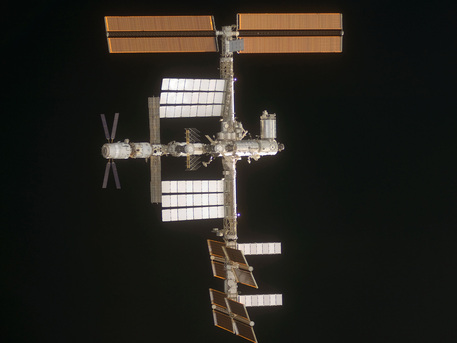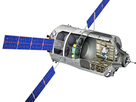Launch of the ATV
ATV – a success story
 © NASA |
ATV Jules Verne docked with the International Space Station (ISS) in April 2008. This picture was taken from the Space Shuttle STS 124. The transporter, recognisable due to its X-shaped solar panels, can be seen on the left as an extension of the central axis of the ISS.
ATV Johannes Kepler will be more capable than its predecessor, ATV Jules Verne. The latter's successful mission in 2008 demonstrated the reliability of the new technology. The knowledge obtained from this first flight was incorporated in the design of ATV-2. It has two more cubic metres of usable volume and can transport an additional 300 kilograms of payload. But ATV Johannes Kepler is not just a freight transporter; it will also be used to boost the orbit of the ISS using its engines. Each of these manoeuvres will raise the altitude of orbit by five to seven kilometres.
Ariane rocket modified for ATV launch
Weighing 20,100 kilograms, ATV Johannes Kepler is the heaviest payload to be carried by a member of the Ariane family. The Ariane 5ES has been adapted specially for ATV missions. Following the launch of ATV Jules Verne on 9 March 2008, this is its second use.At Astrium in Bremen, work continues on the construction of ATVs 3, 4 and 5. ATV-3 is scheduled for delivery to Europe's Spaceport in French Guiana this summer and its launch is planned for February/March 2012. The other ATV launches will follow at one-year intervals.
Source: DLR
Launch of the ATV
ATV – a success story
 © NASA |
ATV Jules Verne docked with the International Space Station (ISS) in April 2008. This picture was taken from the Space Shuttle STS 124. The transporter, recognisable due to its X-shaped solar panels, can be seen on the left as an extension of the central axis of the ISS.
ATV Johannes Kepler will be more capable than its predecessor, ATV Jules Verne. The latter's successful mission in 2008 demonstrated the reliability of the new technology. The knowledge obtained from this first flight was incorporated in the design of ATV-2. It has two more cubic metres of usable volume and can transport an additional 300 kilograms of payload. But ATV Johannes Kepler is not just a freight transporter; it will also be used to boost the orbit of the ISS using its engines. Each of these manoeuvres will raise the altitude of orbit by five to seven kilometres.
Ariane rocket modified for ATV launch
Weighing 20,100 kilograms, ATV Johannes Kepler is the heaviest payload to be carried by a member of the Ariane family. The Ariane 5ES has been adapted specially for ATV missions. Following the launch of ATV Jules Verne on 9 March 2008, this is its second use.At Astrium in Bremen, work continues on the construction of ATVs 3, 4 and 5. ATV-3 is scheduled for delivery to Europe's Spaceport in French Guiana this summer and its launch is planned for February/March 2012. The other ATV launches will follow at one-year intervals.
Source: DLR






